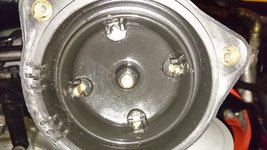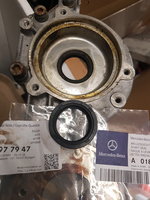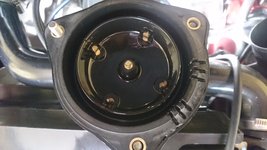For the past 4 years, you have seen the Red Baron (1of1 Brabus 6.5 based on 1of 147 Factory E60 AMG) move from one achievement to another. From classic cars shows, to motorsport events, to national Concours d'Elegance competitions, to prominent international carshows and tier 1 international concours d'Elegance competitions. The Red baron continued to improve from one show to another both technically and cosmetically, and I continued expand the documentation and history files. We are a long way from where we started 4 years ago.
I dedicate this to my fellow 124036 owners all over the world, I hope to have made a small contribution to this community and made you all a bit more proud of owning this car.
---------------------
- Now to the main event: the Red baron as with many 124036 all over the world developed a misfire at idle, but this might have been the most difficult case yet for the following reasons:
1 - The technical differences to standard 124036, the issue was much more difficult to diagnose as you can't compare against other 500E/E500 and not even with E60s, I Could not swap parts with another car (nor did I have another 124036 to swap parts with), I must say that ( B ) did not provide any assistance (not even to the M-B Dealership) and said the car must be brought to B HQ... I later found out why.
2 - Multiple small intermittent issues causing the same symptoms that made pin pointing the exact issue impossible.
3 - Factory diagnostic tool showed nothing! live data was misleading and caused us to replaced a number of parts that were not the issue.
4- The distributor misfire is a well known issue in the M119 community, and the symptoms are known by now. It was showing different symptoms.
- Who was involved: The issue did not start in Q8 but rather in the UK, car was smoother in Q8. So our independent master tech in Q8 was only able to contribute over the phone, but of course was helpful. In Germany it went to a M-B Dealerships with a youngtimer master tech and a Bosch center specializing in youngtimer cars. A mercedes youngtimer parts manufacturer, A mercedes Youngtimer specialist in New York, During a carshow last year it was looked at by two M-B young timer specialists at the same time (one from Kuppenheim, the other from bochum), and finally this year at Technoclassica it was checked by a very prominent Automotive figure from Bottrop (see thread Red baron at Technoclassica).
Throughout all this I was reading every forum, magazine article, website, repair video, workshop document there is. We ended up changing and upgrading all the usual suspects and a few more. ALL of which had zero effect !! You can imagine the frustration and $$$$ assiociated with all this, only thing that cheers me up is seeing it at the shows.
- Symptom: Intermittent hiccup (misfire) at warm idle, no issues during cold start/warmup, not divisibility issues at high speed, kick down or acceleration.
- Why was it impossible to diagnose? car was showing constant lean running condition, everyone mentioned above had the exact same conclusion.
- Was there a lean condition? No, exhaust smells of fuel while Star says constant lean, hence the confusion.
- Why a constant lean if it just an Intermittent misfire? here is where the specific technical specification comes into place,
I dedicate this to my fellow 124036 owners all over the world, I hope to have made a small contribution to this community and made you all a bit more proud of owning this car.
---------------------
- Now to the main event: the Red baron as with many 124036 all over the world developed a misfire at idle, but this might have been the most difficult case yet for the following reasons:
1 - The technical differences to standard 124036, the issue was much more difficult to diagnose as you can't compare against other 500E/E500 and not even with E60s, I Could not swap parts with another car (nor did I have another 124036 to swap parts with), I must say that ( B ) did not provide any assistance (not even to the M-B Dealership) and said the car must be brought to B HQ... I later found out why.
2 - Multiple small intermittent issues causing the same symptoms that made pin pointing the exact issue impossible.
3 - Factory diagnostic tool showed nothing! live data was misleading and caused us to replaced a number of parts that were not the issue.
4- The distributor misfire is a well known issue in the M119 community, and the symptoms are known by now. It was showing different symptoms.
- Who was involved: The issue did not start in Q8 but rather in the UK, car was smoother in Q8. So our independent master tech in Q8 was only able to contribute over the phone, but of course was helpful. In Germany it went to a M-B Dealerships with a youngtimer master tech and a Bosch center specializing in youngtimer cars. A mercedes youngtimer parts manufacturer, A mercedes Youngtimer specialist in New York, During a carshow last year it was looked at by two M-B young timer specialists at the same time (one from Kuppenheim, the other from bochum), and finally this year at Technoclassica it was checked by a very prominent Automotive figure from Bottrop (see thread Red baron at Technoclassica).
Throughout all this I was reading every forum, magazine article, website, repair video, workshop document there is. We ended up changing and upgrading all the usual suspects and a few more. ALL of which had zero effect !! You can imagine the frustration and $$$$ assiociated with all this, only thing that cheers me up is seeing it at the shows.
- Symptom: Intermittent hiccup (misfire) at warm idle, no issues during cold start/warmup, not divisibility issues at high speed, kick down or acceleration.
- Why was it impossible to diagnose? car was showing constant lean running condition, everyone mentioned above had the exact same conclusion.
- Was there a lean condition? No, exhaust smells of fuel while Star says constant lean, hence the confusion.
- Why a constant lean if it just an Intermittent misfire? here is where the specific technical specification comes into place,



 I don't know what I was expecting with the lead up- but not that so many had missed the very typical m119 distributer issues
I don't know what I was expecting with the lead up- but not that so many had missed the very typical m119 distributer issues  Nothing really new here - sorry
Nothing really new here - sorry


















